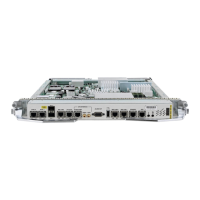Dynamic Single-Segment Pseudowire
A single-segment pseudowire (SS-PW) is a point-to-point pseudowire (PW) where the PW segment is present
between two PE routers.
In this feature, a single-segment pseudowire is established between two PE routers of the same autonomous
system (AS) dynamically using the FEC 129 information. The objective of this feature is to ensure
interoperability of the Cisco routers with the third-party routers.
Active and Passive Signaling
The T-PE on which the SS-PW is initiated and the signaling message is transmitted from is called as the
source-terminating PE (ST-PE). The T-PE that waits and responds to the SS-PW signaling message is called
the target-terminating PE (TT-PE).
The signaling flow from the ST-PE to TT-PE is referred to as the forward direction signaling or the active
signaling. The signaling flow from the TT-PE to ST-PE is referred to as the reverse direction signaling or the
passive signaling.
Generally, the PE with the highest prefix address takes the active role and becomes the ST-PE, and the other
PE becomes the passive TT-PE.
The following figure illustrates the SS-PW signaling flow between ST-PE and TT-PE:
Figure 16: Single-Segment Pseudowire Between ST-PE and TT-PE
Functionality of Dynamic Single Segment Pseudowire
The dynamic discovery of the pseudowire path from the ST-PE to the T-PE is achieved using the L2 route
table. The route table entries, that is, a list of prefix and associated next-hops to the L2VPN are populated by
BGP.
In Release 5.1.2, Cisco supports only the routable prefix to reach the TAII on the T-PE. The routable prefix
is the neighbor address of the targeted-LDP session. The reachability of packets from the source to the
destination is achieved by user configurations (see Configuring L2VPN Single Segment Pseudowire, on page
93) However, BGP supports MS-PW Subsequent Address Family Identifiers (SAFI) that is used to exchange
the L2 routes across all the PEs. SS-PW uses the BGP MS-PW address family to function. To ensure
interoperability with other third-party routers, Cisco advertises a single BGP MS-PW route per T-PE where
the value of AC-ID (attachment circuit-identifier) is a wild-card entry.
Note
The supported pseudowire features are pw-status, pw-grouping, and tag-impose vlan.
The following figure illustrates the E-line Services Network with SS-PWs:
L2VPN and Ethernet Services Configuration Guide for Cisco ASR 9000 Series Routers, IOS XR Release 6.3.x
92
Implementing Point to Point Layer 2 Services
Dynamic Single-Segment Pseudowire

